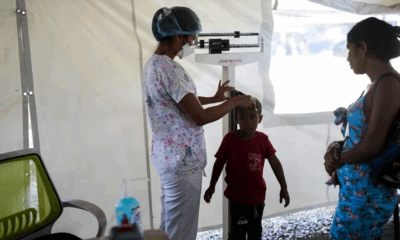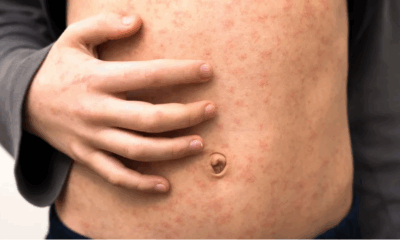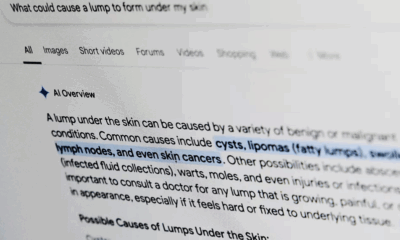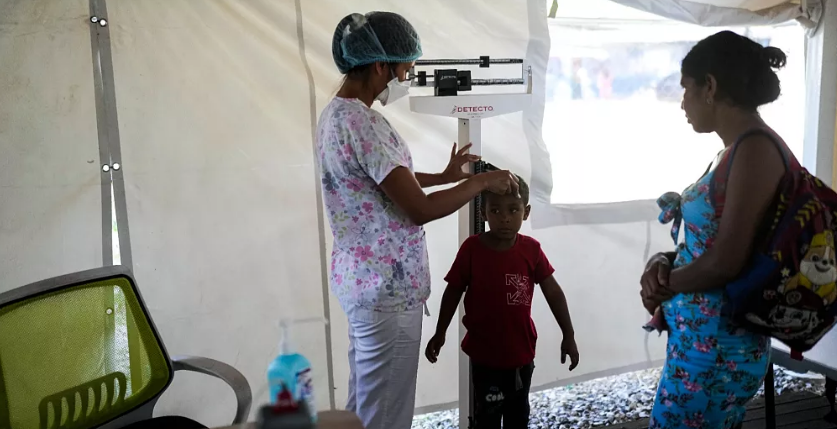Health
Global Obesity Rates Expected to Soar by 2050, Study Warns
A new study published in The Lancet projects that by 2050, nearly 60% of adults and 31% of children and young people worldwide will be overweight or obese, marking a sharp increase from previous decades. The research highlights a growing health crisis, with experts warning of serious consequences for global well-being.
A Worsening Trend
According to the study, 3.8 billion adults and 746 million young people are expected to be overweight or obese by mid-century. This marks a significant rise from 1990 figures when 731 million adults and 198 million young people were classified as overweight or obese. The findings show that each new generation is gaining weight earlier and faster than before.
For example, in high-income countries, 7% of men born in the 1960s were obese by the age of 25, but this percentage increased to 16% for men born in the 1990s and is expected to reach 25% for those born in 2015. This trend is fueling an epidemic linked to type 2 diabetes, high blood pressure, heart disease, and certain cancers.
Emmanuela Gakidou, one of the study’s authors, called the obesity crisis a “monumental societal failure.”
Global Hotspots for Obesity
The study identified several countries as obesity hotspots. In 2021, over half of the world’s overweight or obese adults were concentrated in just eight countries:
- China (402 million)
- India (180 million)
- United States (172 million)
- Brazil (88 million)
- Russia (71 million)
- Mexico (58 million)
- Indonesia (52 million)
- Egypt (41 million)
Future growth in obesity rates is expected to be driven by population increases in Asia and sub-Saharan Africa. Among high-income nations, the United States, Chile, and Argentina are projected to have the highest obesity rates. In Europe, Greece is forecasted to have the highest levels of obesity by 2050, affecting 48% of women and 41% of men.
Impact on Healthcare Systems
As obesity rates climb, so do associated health risks. The study estimates that by 2050, one in four obese adults worldwide will be over 65, adding further strain on global healthcare systems. The effects are already being felt in countries like the U.S., Australia, and parts of Europe, where obesity-related health complications are lowering life expectancy and quality of life.
Despite these alarming trends, research suggests that only 7% of countries worldwide have healthcare systems prepared to tackle the rising obesity-related health burdens. Experts warn that without intervention, obesity will continue to drive millions of premature deaths annually from conditions like diabetes, heart disease, cancer, and stroke.
Rising Obesity Rates Among Young People
The research also paints a troubling picture for younger generations. While most young people in 2050 are expected to be overweight rather than obese, childhood and adolescent obesity rates are set to increase by 121%.
Obesity is expected to rise sharply in North Africa, the Middle East, Latin America, and the Caribbean, as well as in large nations such as the U.S. and China. Among high-income nations, Chile is forecasted to have the highest childhood obesity rates, while the U.S. will lead in obesity among young adults (ages 15-24). In Europe, Greece and San Marino will have the highest rates among boys and girls, respectively.
Dr. Jessica Kerr, one of the study’s authors, emphasized that interventions are still possible, saying, “If we act now, we can prevent a complete transition to global obesity for children and adolescents.”
Calls for Policy Changes
Experts argue that addressing the crisis requires more than just medical treatments. The study measured obesity using body mass index (BMI), a widely used metric, but one that some researchers say should be replaced with more precise health indicators.
Meanwhile, new weight-loss drugs, such as GLP-1 receptor agonists, have been hailed as potential game-changers, but experts caution that medications alone cannot stop the obesity epidemic.
Johanna Ralston, CEO of the World Obesity Federation, warned that tackling obesity requires comprehensive policy changes. Strategies such as food labeling, taxation on unhealthy foods, and better urban planning to encourage physical activity are crucial to combating the crisis.
“We can’t just treat our way out of it. We need to change the way we approach food and exercise as a society,” Ralston said.
The findings underscore the urgent need for a global, multi-pronged strategy to address the obesity epidemic before it becomes an even greater public health catastrophe.
Health
Early-Onset Cancer Rates Rising in U.S., But Deaths Mostly Stable, Study Finds

A new U.S. government study has revealed that while cancer diagnoses among people under 50 are on the rise, the overall death rates for most types of cancer in this age group remain stable.
Published Thursday in the journal Cancer Discovery, the study is one of the most comprehensive assessments to date of early-onset cancers, analyzing data from more than two million cases diagnosed in Americans aged 15 to 49 between 2010 and 2019.
The findings show that 14 out of 33 cancer types had increasing incidence rates in at least one younger age group. The most significant increases were seen in breast, colorectal, kidney, and uterine cancers. Women accounted for about 63 percent of the early-onset cases.
“This pattern generally reflects something profound going on,” said Tim Rebbeck of the Dana-Farber Cancer Institute, who was not involved in the study. “We need to fund research that will help us understand why this is happening.”
The study found that, compared to 2010 data, there were 4,800 more breast cancer cases, 2,000 additional colorectal cancers, 1,800 more kidney cancers, and 1,200 extra uterine cancers by 2019.
Despite the rising numbers, researchers emphasized a key reassurance: death rates for most of these cancers are not increasing. However, exceptions were noted—colorectal, uterine, and testicular cancers saw slight rises in mortality among younger adults.
The causes behind the rise in early-onset cancers are not fully understood. The study’s datasets do not include information on potential risk factors such as obesity, lifestyle, or access to healthcare. However, researchers, including lead author Dr. Meredith Shiels of the National Cancer Institute, highlighted obesity as a possible driver.
“Several of these cancer types are known to be associated with excess body weight,” said Dr. Shiels. She also pointed to advances in detection and changing screening practices as possible contributors to earlier diagnoses.
Breast cancer trends may also be influenced by shifting reproductive patterns, such as women having children later in life, which has been associated with increased cancer risk due to fewer years of pregnancy and breastfeeding—factors known to lower risk.
Not all cancer types followed the upward trend. Rates of more than a dozen cancers, including lung and prostate cancer, are decreasing among younger people. Researchers attribute the lung cancer decline to reduced smoking rates, while updated PSA screening guidelines are likely behind the drop in prostate cancer diagnoses.
Experts plan to convene later this year to further investigate the growing early-onset cancer burden and explore targeted prevention strategies.
Health
UK Scientists Develop Tool to Measure ‘Heart Age,’ Offering New Insights for Cardiovascular Health

Researchers in the United Kingdom have developed a new tool that can determine how old a person’s heart is in comparison to their actual age, offering a potential breakthrough in the early detection and prevention of cardiovascular disease.
The study, led by scientists at the University of East Anglia (UEA), examined magnetic resonance imaging (MRI) scans from 557 individuals across the UK, Spain, and Singapore. Of those, 336 participants had known health risk factors such as obesity, high blood pressure, or diabetes.
Using these scans, the researchers measured structural and functional markers of cardiac health — including the size of the heart’s chambers and how effectively it pumps blood. These indicators were then used to create an algorithm that calculates the heart’s “functional age.”
The findings, published in the European Heart Journal, revealed that individuals with cardiovascular risk factors had hearts that were, on average, 4.6 years older than their chronological age. In people with obesity, the gap was even wider, indicating faster cardiac ageing.
“People with health issues like diabetes or obesity often have hearts that are ageing faster than they should – sometimes by decades,” said Dr. Pankaj Garg, a cardiologist and lead author of the study. “This tool gives us a way to visualize and quantify that risk.”
While the tool shows promise, researchers noted some limitations. The model does not account for how long patients had lived with their conditions, and the study group primarily included older individuals who had survived with these health issues — raising concerns about survivor bias. The relatively small sample size also means the tool needs broader validation before it can be widely adopted.
Despite these limitations, the research team believes the tool could have valuable clinical applications in the future. Dr. Garg said it may help doctors counsel patients more effectively about their cardiovascular health and recommend lifestyle changes or treatments to slow heart ageing.
“By knowing your heart’s true age, patients could get advice or treatments to slow down the ageing process, potentially preventing heart attacks or strokes,” he said. “It’s about giving people a fighting chance against heart disease.”
The team hopes the tool could eventually be integrated into routine care, empowering patients to take early steps toward improving their heart health through diet, exercise, and medical intervention.
Health
Global Health Inequities Persist as Progress on Life Expectancy and Mortality Slows, Says WHO
-

 Business12 months ago
Business12 months agoSaudi Arabia’s Model for Sustainable Aviation Practices
-

 Business12 months ago
Business12 months agoRecent Developments in Small Business Taxes
-

 Politics12 months ago
Politics12 months agoWho was Ebrahim Raisi and his status in Iranian Politics?
-

 Business10 months ago
Business10 months agoCarrectly: Revolutionizing Car Care in Chicago
-

 Business10 months ago
Business10 months agoSaudi Arabia: Foreign Direct Investment Rises by 5.6% in Q1
-

 Technology12 months ago
Technology12 months agoComparing Apple Vision Pro and Meta Quest 3
-

 Politics12 months ago
Politics12 months agoIndonesia and Malaysia Call for Israel’s Compliance with ICJ Ruling on Gaza Offensive
-

 Technology12 months ago
Technology12 months agoRecent Developments in AI Ethics in America





























